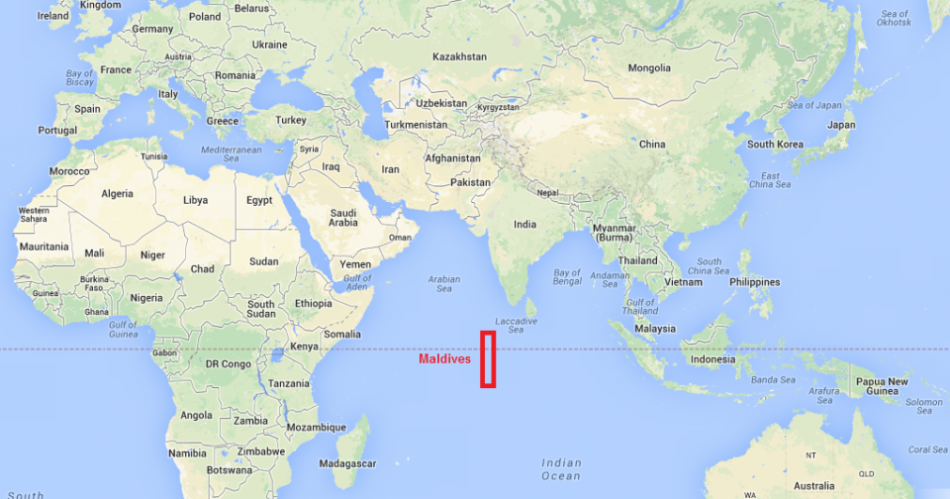The Maldives archipelago nestles in the central Indian Ocean, strategically located near the main international shipping routes that cross the ocean. In recent times, as China has sought to enhance its global presence in new areas, the Indian Ocean has become an important region of contestation between China and the two main maritime powers in the region, India, and America.
The Maldives has been wooed in the past decade by China, America and India, which is the island nation’s closest maritime neighbor. The Maldives is of obvious strategic interest for India, but China and the United States have intensified their efforts to forge closer ties with the Maldives government in recent times.
As China develops a more forceful presence in the Indian Ocean, both maritime and through its Maritime Silk Route initiative, a part of its Belt and Road Initiative (BRI), the tussle for influence has intensified. More so, since the US articulated its Indo-Pacific strategy for a free and open Indo-Pacific. Beijing views the Indo-Pacific strategy as targeting China. China began its steady ingress into the Indian Ocean under its anti-piracy efforts to combat the menace of piracy in the western Indian Ocean region. It slowly increased its naval presence in the Indian Ocean which is a major route for its energy imports from Africa and West Asian region. Most commercial shipping routes across the Indian Ocean pass close to the Maldivian waters.
Security agreement to counter Chinese push
China has been using its economic clout to tie-up closer connections in the region. Both India and the US have had to factor in China’s push in the region in their own foreign policies.
The US signed a defense and security agreement with the Maldives last week during the visit of Maldives Defense Minister, Mariya Didi to the US. The Maldivian minister described the framework agreement as “an important milestone in defense and security cooperation with the US.” Both sides agreed to work towards holding the first Defense and Security Dialogue and reiterated their commitment to a free and open Indo-Pacific region.
The new defense agreement is a clear shift in the Maldives position towards the US after a period when the government in Male forged close economic and political ties with Beijing. The Chinese embrace that had caused considerable concern to other stakeholders in the region, but did not prove as advantageous as anticipated in Male. This agreement places the Maldives in line with the American led Indo-Pacific concept.
Shift in Indian policy
It also signals a shift in Indian policy. New Delhi has traditionally been wary of American dominance in the region. India had opposed the American base at Diego Garcia, an Indian Ocean island territory claimed by Mauritius. In 2013, the US had proposed signing a Status of Forces Agreement with the Maldives, which was eventually shelved by the Maldives government in the face of Indian disapproval.
In the past decade, there has been a tussle for power in the Indian Ocean Region (IOR), with several countries vying for influence in the maritime space. India’s own bilateral relations with the US has expanded into a strategic partnership with the conclusion of several defense and security agreements. Increasing convergences in their global strategic interests have led to widening cooperation between them on a range of security challenges, ranging from terrorism, piracy, maritime security to disaster relief. As an important power in America’s Indo-Pacific concept, American actions are no longer viewed in India through the same prism as before.
The Maldives friendship with Beijing had flowered with the visit of Chinese President Xi Jinping in 2014 when the Maldives became part of China’s Belt and Road Initiative. As China became a major investor in the Maldives, the two governments concluded a free trade agreement. A change in government in Male and growing Chinese debts led to a re-look at the Chinese connection and a review of agreements and contracts.
The Maldives had leased an island to a Chinese company for a period of 50 years in a controversial deal during this period. Recent satellite pictures had shown that the Chinese had reclaimed land and developed the island to three times its original size. The project, and the secrecy that has surrounded it, has been of concern to India and other countries.
India strengthens ties with Maldives
India has also strengthened its strategic ties with the Maldives, a major connectivity project that would link Male city through sea-bridges and causeways to three islands of Vilimale, Thilafushi, and Gulhifalhu. The high-profile connectivity project is expected to lift the load from the overcrowded capital city which has no space to expand. In this regard, India has announced a “financial package consisting of a grant of US $100 million and a new Line of Credit (LoC) of US $400 million” for the ambitious Greater Malé Connectivity Project (GMCP). The announcement was made by External Affairs Minister (EAM), S. Jaishankar after a meeting through video-conference on August 14 with Maldivian Foreign Minister, Abdulla Shahid.
Geo-strategic dynamics have been changing in the Indian Ocean which has seen increasing Chinese maritime assertiveness. India has enhanced maritime relations with France, which considers itself an Indian Ocean power on the basis of French territories such as Reunion Island in the region. The first virtual meeting of another trilateral group comprising India, France, and Australia, three Indian Ocean based powers, for cooperation in the Indo-Pacific region, was held in Delhi recently. The American defense agreement is an effective counter to Chinese actions in the Maldives.
The Indian Ocean has complex security issues and by aligning with the Indo-US strategy, Maldives has moved away from Chinese influence, but given China’s assertion of its interests in the region, the Indian Ocean will remain an active arena for competing forces for several years.
*The writer is a veteran journalist and foreign affairs analyst.
September 15, 2020


